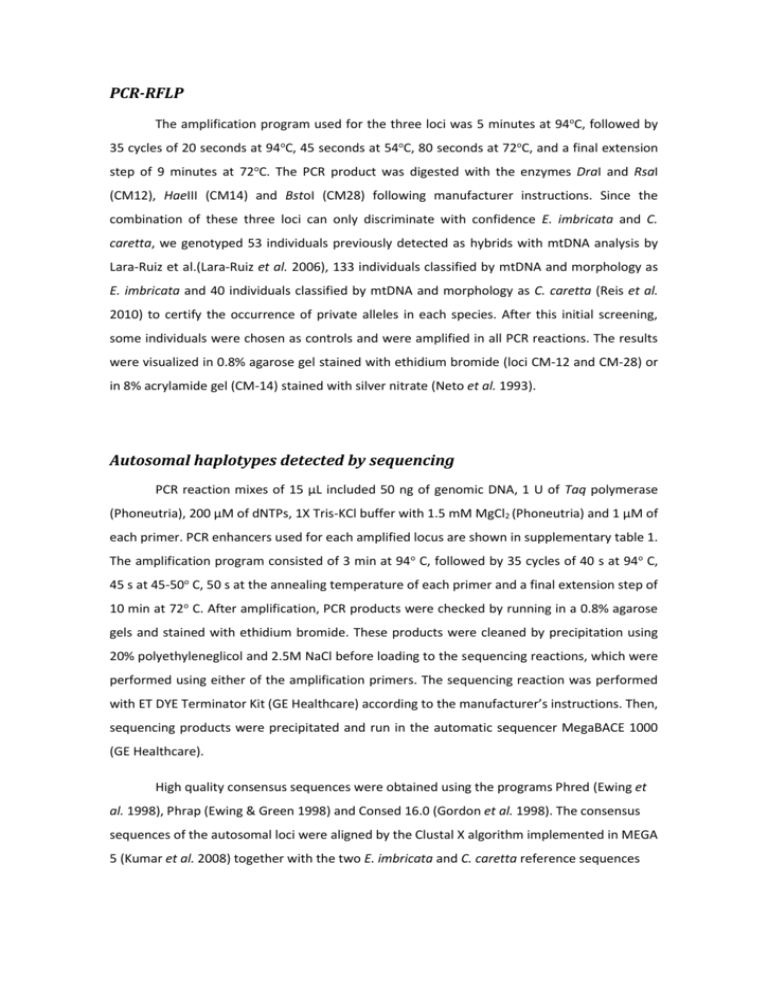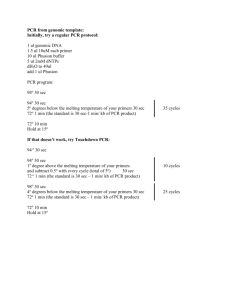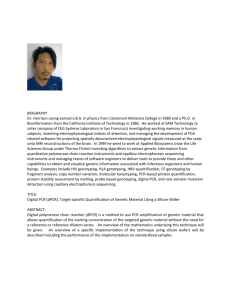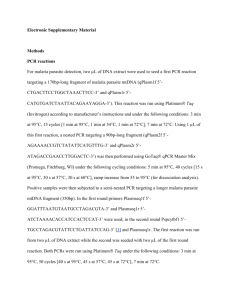Autosomal haplotypes detected by sequencing
advertisement

PCR-RFLP The amplification program used for the three loci was 5 minutes at 94oC, followed by 35 cycles of 20 seconds at 94oC, 45 seconds at 54oC, 80 seconds at 72oC, and a final extension step of 9 minutes at 72oC. The PCR product was digested with the enzymes DraI and RsaI (CM12), HaeIII (CM14) and BstoI (CM28) following manufacturer instructions. Since the combination of these three loci can only discriminate with confidence E. imbricata and C. caretta, we genotyped 53 individuals previously detected as hybrids with mtDNA analysis by Lara-Ruiz et al.(Lara-Ruiz et al. 2006), 133 individuals classified by mtDNA and morphology as E. imbricata and 40 individuals classified by mtDNA and morphology as C. caretta (Reis et al. 2010) to certify the occurrence of private alleles in each species. After this initial screening, some individuals were chosen as controls and were amplified in all PCR reactions. The results were visualized in 0.8% agarose gel stained with ethidium bromide (loci CM-12 and CM-28) or in 8% acrylamide gel (CM-14) stained with silver nitrate (Neto et al. 1993). Autosomal haplotypes detected by sequencing PCR reaction mixes of 15 μL included 50 ng of genomic DNA, 1 U of Taq polymerase (Phoneutria), 200 μM of dNTPs, 1X Tris-KCl buffer with 1.5 mM MgCl2 (Phoneutria) and 1 μM of each primer. PCR enhancers used for each amplified locus are shown in supplementary table 1. The amplification program consisted of 3 min at 94o C, followed by 35 cycles of 40 s at 94o C, 45 s at 45-50o C, 50 s at the annealing temperature of each primer and a final extension step of 10 min at 72o C. After amplification, PCR products were checked by running in a 0.8% agarose gels and stained with ethidium bromide. These products were cleaned by precipitation using 20% polyethyleneglicol and 2.5M NaCl before loading to the sequencing reactions, which were performed using either of the amplification primers. The sequencing reaction was performed with ET DYE Terminator Kit (GE Healthcare) according to the manufacturer’s instructions. Then, sequencing products were precipitated and run in the automatic sequencer MegaBACE 1000 (GE Healthcare). High quality consensus sequences were obtained using the programs Phred (Ewing et al. 1998), Phrap (Ewing & Green 1998) and Consed 16.0 (Gordon et al. 1998). The consensus sequences of the autosomal loci were aligned by the Clustal X algorithm implemented in MEGA 5 (Kumar et al. 2008) together with the two E. imbricata and C. caretta reference sequences published by Naro-Maciel et al. (2008). Polymorphic sites were either identified by visual inspection in Consed or using Polyphred 6.11 (Nickerson et al. 1997; Stephens et al. 2006). Microsatellites Polymerase chain reaction (PCR) mixes of 9 µL included 1 µL of genomic DNA (~40 ng), 1 U of Taq Platinum polymerase (Invitrogen), 200 µM of deoxynucleoside triphosphates, 1 X Tris–KCl buffer (Invitrogen), 1.5 mM MgCl2 (Invitrogen), 1 mM of the forward primer labeled with a m13 tail, 10 mM of the reverse primer and 10 mM of the m13 primer with fluorescence FAM or HEX (Schuelke 2000). The amplification program consisted of 3 min at 94o C, followed by 30 cycles of 30 s at 94o C, 30s at annealing temperatures depending on the locus (55o C for OR1, OR2 and OR3 and 60o C for CC1G02 and Cc1G03), 30 s at 72o C, and a final extension step of 30 min at 72o C. The amplicons were diluted fivefold with Milli-Q water. Genotyping reaction mixes of 10 µL included 2 µL of diluted amplicon, 0.25 µL of ET 550-R (GE Healthcare) and 7.75 µL of Tween20 0.1%. The running conditions followed the manufacturer’s recommendations (GE Healthcare) for genotyping in an automated MegaBACE 1000 DNA analysis system. The peaks were analyzed in the Fragment Profiler Program (GE Healthcare) for allele scoring. The allele distribution was analyzed for the presence of null alleles with the program MicroChecker version 2.2.3 (Van Oosterhout et al. 2004) and the observed and expected heterozygosities were calculated with Arlequin version 3.5 (Excoffier & Lischer 2010). References Ewing B, Green P (1998) Base-calling of automated sequencer traces using phred. Ii. Error probabilities. Genome Research, 8, 186-194. Ewing B, Hillier L, Wendl MC, Green P (1998) Base-calling of automated sequencer traces using phred. I. Accuracy assessment. Genome Research, 8, 175-185. Excoffier L, Lischer HEL (2010) Arlequin suite ver 3.5: A new series of programs to perform population genetics analyses under linux and windows. Molecular Ecology Resources, 10, 564-567. Gordon D, Abajian C, Green P (1998) Consed: A graphical tool for sequence finishing. Genome Research, 8, 195-202. Kumar S, Nei M, Dudley J, Tamura K (2008) Mega: A biologist-centric software for evolutionary analysis of DNA and protein sequences. Briefings in Bioinformatics, 9, 299-306. Lara-Ruiz P, Lopez GG, Santos FR, Soares LS (2006) Extensive hybridization in hawksbill turtles (eretmochelys imbricata) nesting in brazil revealed by mtdna analyses. Conservation Genetics, 7, 773-781. Neto ED, Santos FR, Pena SDJ, Simpson AJG (1993) Sex determination by low stringency pcr (lspcr). Nucleic Acids Research, 21, 763-764. Nickerson DA, Tobe VO, Taylor SL (1997) Polyphred: Automating the detection and genotyping of single nucleotide substitutions using fluorescence-based resequencing. Nucleic Acids Research, 25, 2745-2751. Reis EC, Soares LS, Vargas SM, Santos FR, Young RJ, Bjorndal KA, Bolten AB, Lobo-Hajdu G (2010) Genetic composition, population structure and phylogeography of the loggerhead sea turtle: Colonization hypothesis for the brazilian rookeries. Conservation Genetics, 11, 1467-1477. Schuelke M (2000) An economic method for the fluorescent labeling of pcr fragments. Nature Biotechnology, 18, 233-234. Stephens M, Sloan JS, Robertson PD, Scheet P, Nickerson DA (2006) Automating sequencebased detection and genotyping of snps from diploid samples. Nature Genetics, 38, 375-381. Van Oosterhout C, Hutchinson WF, Wills DPM, Shipley P (2004) Micro-checker: Software for identifying and correcting genotyping errors in microsatellite data. Molecular Ecology Notes, 4, 535-538.







